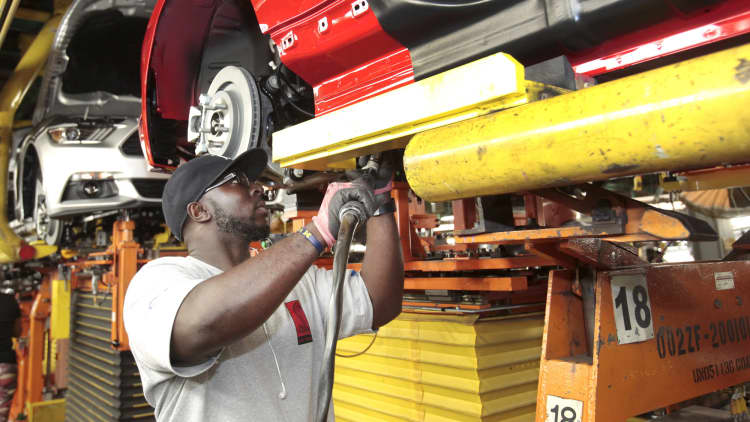
Ford beat Wall Street expectations Thursday, driven in large part by cost reductions and strong sales in North America.
The company said it has been cost cutting across several departments. Costs were also comparably lower this quarter because Ford suffered a massive recall of its vehicles this time last year. Last year Ford had to recall almost 2.4 million vehicles spanning several models, such as the Mustang, Focus, and Lincoln MKC.
Ford tightened a full-year adjusted earnings per share guidance range of $1.75-$1.85, which is narrower than its prior range of $1.65-$1.85.
Here's how the company did compared to what Wall Street expected:
- Adjusted EPS: 43 cents vs. 32 cents expected by analysts surveyed by Thomson Reuters.
- Revenue: $36.5 billion vs. $32.8 billion expected in the Thomson Reuters survey.
"Clearly we have a lot of work ahead of us but this was a solid quarter," said Ford CEO Jim Hackett on a conference call with investors Thursday morning.
Shares of Ford were up almost 2 percent in pre-market trading on Thursday. Ford's stock has barely moved at all this year, while shares of rival General Motors have risen roughly 30 percent. Tesla shares have climbed more than 50 percent.
Strong performance in North America and a record pre-tax profit in Asia drove automotive profits, Ford said.
In some ways Ford is benefiting from a shift toward trucks and SUVs among consumers. In the U.S., the company's F-Series truck lineup had its best third quarter since 2005. F-Series sales were up 14 percent in the quarter.
Overall, average transaction prices rose more than twice the industry average in the U.S., and incentives decreased.
Pre-tax profits for North America were 1.7 billion.
Results from Ford's international businesses were mixed. Ford's Asia-Pacific business pulled in pre-tax profits of $289 million. But the company lost $86 million in Europe, which it attributed in part to the effects of Brexit, and the launch of the Fiesta. It also lost $158 million in South America and $60 million in the Middle East and Africa.
On a per share basis, net earnings rose to 39 cents, a 15 cent increase over the same quarter last year.
On an adjusted basis, the company reported third-quarter earnings of 43 cents a share, which outpaced analyst expectations of 32 cents. Earnings per share in the same quarter last year were 26 cents.
Ford reported $36.5 billion in revenue, beating analyst expectations of $32.8 billion.
Net income was $1.6 billion, compared with $1 billion in the same quarter of 2016.
Adjusted pre-tax profit of $2 billion was $548 million higher than the same quarter last year, driven by favorable costs and market factors, the company said.
"I would say to investors, we have already created value, we have had a strong seven-year run," Ford CFO Bob Shanks told CNBC's Squawk Box Thursday. "This year is going to be another good year."
Shanks said Ford is improving its fiscal health as the industry moves further into new automotive technologies, such as electric and autonomous vehicles. Ford plans to bring an autonomous vehicle to market in 2021 and an electric vehicle in 2020.
Since hiring new CEO Jim Hackett, Ford is cutting costs and shaking up the senior leadership team. Shares of the No. 2 U.S. automaker have barely budged since the beginning of the year, while shares of rival General Motors have risen roughly 30 percent. Shares of upstart Tesla have risen more than 50 percent.
Like rival GM, Ford has been taking steps to refocus its lineup on trucks, SUVs and crossovers. The company is also rushing to invest in new mobility technologies to compete with efforts from other automakers and cash-rich Silicon Valley firms.
Ford still expects operating margin and profit for 2017 to be lower than it was last year, citing factors such as higher costs commodities and increased engineering expenses for commercial and autonomous vehicles.
Several analysts have expressed caution about the stock in the near term.
Hackett has "a solid long-term vision," said RBC capital analyst Joseph Spak in a recent note, but he cautioned that Ford is still very early in its turnaround.
"To be frank, aside from some cost-cutting that may be realizable, given the lead times in auto," Spak said, "most of whatever Mr. Hackett proposes wouldn't have an impact until 2019 or 2020 at the earliest."


